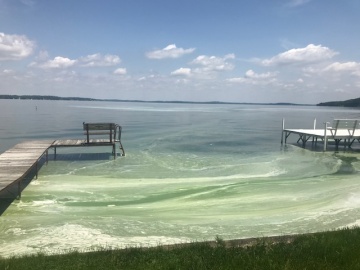Blue-Green Algae Precautions

Blue-green algae, also known as cyanobacteria, is harmful to people and pets. Before getting in the water, always look at the water around you and don't get in the water if you see blue-green algae.
You can check our website to learn the water conditions for beaches we monitor.
Water conditions can change quickly, and a test result may not always reflect the current water quality.
Spotting a Blue-Green Algae Bloom
Despite its name, blue-green algae may not always be blue-green. It may also be reddish-purple or brown. Blue-green algae causes the water to be murky. See photos of blue-green algae.
When environmental conditions are just right, blue-green algae can grow very quickly. Most species are buoyant and will float to the surface, where they form scum layers or floating mats.
If you see a blue-green algae bloom, please send us an email!
Be Careful Around Blue-Green Algae Blooms
Do not:
- Swim in water that looks like "pea soup", green or blue paint, or that has a scum layer or puffy blobs floating on the surface.
- Boat, kayak, or water ski in water with blue-green algae (you can breathe in the toxins).
- Let children play with scum layers, even from shore.
- Let pets or livestock swim in or drink water with blue-green algae blooms.
- Treat water that has blue-green algae blooms with any herbicide or algaecide - toxins are released into the water when blue-green algae cells die.
If You Have Been in the Water with Blue-Green Algae
- Rinse off well when you get out.
- If you have symptoms, call your health care provider or Poison Control Center at 1-800-222-1222.
- Report a blue-green algae bloom or illness to the Wisconsin Harmful Algal Blooms Program.
Tips for Dog Owners
Your dog doesn't know to avoid blue-green algae. They may drink the water or lick it off their fur and get sick, or even die. Because they're smaller than humans, it doesn't take much drinking or licking for this to happen.
- Always look at the water around you before letting your dog swim or wade.
- Give your dog fresh water to minimize the amount of lake water they drink.
- Rinse your dog off as soon as possible after being in the water. Since dogs often lick their fur, they can swallow toxins even after they are dry.
If your dog has been in the water near a blue-green algae bloom and they seem sick, call your vet.
You Can Help Reduce the Frequency and Intensity of Blue-Green Algae Blooms
There is no quick and easy fix once blue-green algae appears in a lake or pond. Reducing the amount of nutrients that wash into our lakes and ponds will eventually help, but it may take a long time and a lot of community involvement.
How you can help:
- Limit the use of lawn fertilizers
- Don't use fertilizers that contain phosphate
- Perform routine maintenance on your septic system
- Keep leaves and grass clippings from washing into storm drains
- Plant native plants along the shoreline to help keep the water clean


